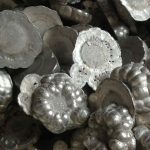Notice: Undefined index: sith_hide_share in /www/sites/alloy.wiki/index/wp-content/themes/likegoogle/single.php on line 32
Deprecated: get_settings is deprecated since version 2.1.0! Use get_option() instead. in /www/sites/alloy.wiki/index/wp-includes/functions.php on line 4862
Some examples of hydrogen embrittlement in titanium bar processing show that hydrogen embrittlement is local. Crevice corrosion, pitting corrosion, galvanic corrosion, stress corrosion and so on can cause hydrogen absorption and local hydrogenation of titanium bar.

Although the causes of crevice corrosion and pitting are different, they are developed according to the principle of blocking battery. At a certain stage of corrosion, hydrolysis reaction will occur, resulting in a large number of H+ :
Due to the large amount of H+, the pH value of the solution in the gap or point is significantly lower, which can reach 1-1.6, or even as low as 0.7. This will further promote the dissolution of the titanium, which forms what is called autocatalysis, allowing local corrosion to develop at a very high rate. At the same time, H precipitates out in the cathode area, and part of it is absorbed by titanium, so it will cause local hydrogenation. Stress corrosion has a similar situation, so that some scholars believe that stress corrosion is a hydrogen embrittlement.
There are many reports of hydrogen embrittlement caused by galvanic corrosion. Titanium and steel contact to form an electric couple in the high-temperature seawater conversion equipment, and the titanium tube in the condenser of the power station is connected with each copper gold tube plate to form an electric couple, all of which may be caused by hydrogen absorption and partial hydrogenation of titanium due to the electric couple corrosion. Hydrogen absorption of titanium in contact with heterogeneous metals in degassed salt water and pure water. The potential of titanium decreases after contact with some metals. For example, the potential of titanium in seawater is 0.14v/SCE, the potential in contact with zinc is -0.79v/SCE, and the potential in contact with steel in 6%Na solution is -0.8v/SCE. Titanium causes hydrogen uptake when the potential drops to -0.65– 0.7v/SCE after contact with these metals in seawater. The results of galvanic corrosion are related to the stability potential, contact area and polarization characteristics of the metal in contact with each other.
According to the hydrogen absorption in 1MFe(OH)2 solution of expanding tube specimens of different materials. It seems that the steel tube plate makes titanium hydrogenation the most (whether after the expansion of the tube pickling or not), the navy brass tube plate after the expansion of the pickling is also hydrogenation a lot.
According to the results of cathode treatment of samples with different surface states in 0.1 MH2SO4 at 30℃. Apparently, the abrasion of the titanium surface caused severe hydrogen uptake. The condition of supply followed, indicating that the surface was also contaminated to a considerable degree.
The hydrogen embrittlement of titanium bars in electrolyte solutions is a complex problem involving many factors in the "material" environment "system, which will be described in detail later.
Guest contributors are welcome at the Alloy Wiki.It is a weekly wiki and guide on alloy information and processing technology, while also about the vast array of opportunities that are present in manufacturing. Our team of writers consists of a Machining Material Supplier / Machinist / Tool and Die Maker, a Biomedical Engineer / Product Development Engineer, a Job Development Coordinator / Adjunct Professor, and a President and CEO of a manufacturing facility.
Link to this article:The titanium bar is locally corroded in the electrolyte melt
Reprint Statement: If there are no special instructions, all articles on this site are original. Please indicate the source for reprinting:Alloy Wiki,thanks!^^


